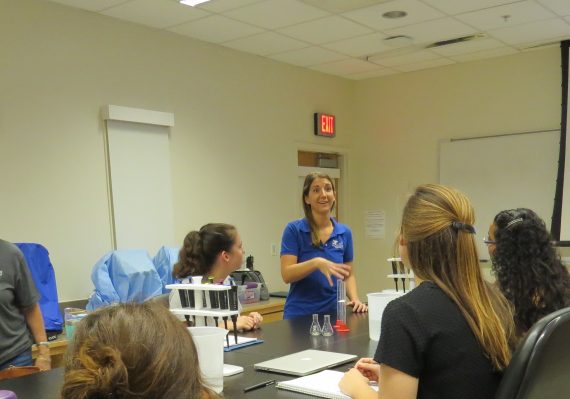The J. Crayton Pruitt Family Department of Biomedical Engineering recently hosted Engineering for Biology: Multidisciplinary Research Experiences for Teachers in Elementary Grades (MRET). Dr. Chelsey Simmons, BME affiliate and assistant professor in the Department of Mechanical and Aerospace Engineering, is the lead PI for the NSF grant and is working with Dr. Stephen Arce, UF BME lecturer, to coordinate lab space.
MRET is an integrated program to bring together K-5 teachers, engineering faculty, engineering students, and industry professionals to cultivate the next generation of STEM professionals. The goal of MRET is to alleviate a present gap in K-5 teacher preparation and to catalyze North Central Florida’s STEM education ecosystem.
MRET invited six elementary (K-5) teachers from Alachua County schools. Teachers leveraged their engagement in the lab to incorporate elements of STEM professional practices into their curriculum across many subjects. Throughout the six-week immersive research experience, the teachers developed lesson plans that they will give to their students when they go back to school.
The department’s state-of-the-art Cell and Tissue Engineering Laboratory was used as the MRET educational facility which offered space for the teachers to engage in scientific discovery and develop analytical methods for STEM education.
“The cell lab helps us to prepare our biomedical engineering students for graduate school, professional school and competitive jobs in the field of tissue engineering; it is an excellent resource to introduce core concepts to teachers at the K-5 level to promote STEM education in our community,” said Arce.
BME students Daniel Stewart (Ph.D., PI: Simmons) and Olivia Lanier (Ph.D., PI: Dobson and McFetridge) along with postdoc Adam Monsalve (PI: Dobson) mentored the teachers full time in the lab and taught training sessions to prepare the teachers for their time in the lab. The teachers worked with the BME students to learn cell culture, functionalize magnetic nanoparticles and synthesize ferrofluids.
“While the teachers will not use the direct skillset they learned in the lab, they will be able to use their new knowledge to create meaningful STEM lessons for their students,” said Olivia Lanier. “For example, they will be able to teach their students to think like a scientist by forming a hypothesis and experimentally testing it. They will also promote collaboration between students in order to get the best results, as they saw firsthand how important collaboration is between labs/labmates here at UF.”
